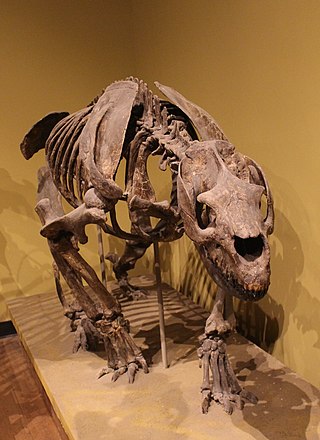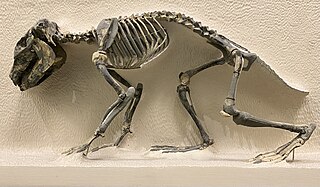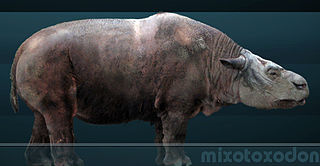
Notoungulata is an extinct order of ungulates that inhabited South America from the early Paleocene to the end of the Pleistocene, living from approximately 61 million to 11,000 years ago. Notoungulates were morphologically diverse, with forms resembling animals as disparate as rabbits and rhinoceroses. Notoungulata are the largest group of South American native ungulates, with over 150 genera in 14 families having been described, divided into two major subgroupings, Typotheria and Toxodontia. Notoungulates first diversified during the Eocene. Their diversity declined from the late Neogene onwards, with only the large toxodontids persisting until the end of the Pleistocene, perishing as part of the Late Pleistocene megafauna extinctions along with most other large mammals across the Americas. Collagen sequence analysis suggests that notoungulates are closely related to litopterns, another group of South American ungulates, and their closest living relatives being perissodactyls, including rhinoceroses, tapirs and equines as part of the clade Panperissodactyla. However their relationships to other South American ungulates are uncertain. Several groups of notoungulates separately evolved ever-growing cheek teeth.

South American native ungulates, commonly abbreviated as SANUs, are extinct ungulate-like mammals that were indigenous to South America from the Paleocene until the end of the Late Pleistocene. They represented a dominant element of South America's Cenozoic terrestrial mammal fauna prior to the arrival of living unguate groups in South America during the Pliocene and Pleistocene as part of the Great American Interchange. They comprise five major groups conventionally ranked as orders—Astrapotheria, Litopterna, Notoungulata, Pyrotheria, and Xenungulata—as well as the primitive "condylarth" groups Didolodontidae and Kollpaniinae. It has been proposed that some or all of the members of this group form a clade, named Meridiungulata, though the relationships of South American ungulates remain largely unresolved. The two largest groups of South American ungulates, the notoungulates and the litopterns, were the only groups to persist beyond the mid Miocene. Only a few species of notoungulates and litopterns survived until the end-Pleistocene extinction event around 12,000 years ago where they became extinct with most other large mammals in the Americas, shortly after the first arrival of humans into the region.

Homalodotherium is an extinct genus of South American native ungulates in the order Notoungulata. Fossils of Homalodotherium have been found in the Middle Miocene Santa Cruz Formation of Argentina and the Río Frías Formation of Chile. The first specimen, a partial skull, was discovered by Robert Holiver Cunningham while on an expedition to Patagonia. By the time it had arrived in England, it was degraded to the point where only a few elements remained. Regardless, in 1870, it was given its genus name by Thomas Henry Huxley, and its species name by William Henry Flower. The name was misspelled repeatedly over the years, leading to the erection of the family Homalodontotheriidae to include it, though this has since been amended to Homalodotheriidae. Since, then four more species of Homalodotherium have been named.

Notostylopidae is an extinct family comprising five genera of notoungulate mammals known from the Late Paleocene (Riochican) to Early Oligocene (Tinguirirican) of Argentina, Brazil and Chile in South America

Homalodotheriidae is an extinct family comprising four genera of notoungulate mammals known from the Late Eocene (Tinguirirican) through Late Miocene (Chasicoan) of Argentina and Chile in South America.

Hegetotheriidae is an extinct family of notoungulate mammals known from the Oligocene through the Pliocene of South America.

Interatheriidae is an extinct family of notoungulate mammals from South America. Interatheriids are known from the Middle Eocene (Mustersan) to the Early Pleistocene (Uquian). These animals were principally small-sized, occupying a habitat like hares, marmots and viscachas. The majority were very small, like rodents.

Isotemnidae is an extinct family of notoungulate mammals known from the Paleocene to Middle Miocene of South America.

Notohippidae is a paraphyletic extinct family of notoungulate mammals from South America. Notohippids are known from the Eocene and Oligocene epochs.
Henricosborniidae is a family of extinct notoungulate mammals known from the Late Paleocene to Middle Eocene of Argentina, Bolivia and Brazil. The name honors U.S. paleontologist Henry Fairfield Osborn.
Oldfieldthomasiidae is an extinct family of notoungulate mammals known from the Late Paleocene to Late Eocene of South America. The family was classified by George Gaylord Simpson in 1945 and a synonym is Acoelodidae, defined by Florentino Ameghino in 1901.

Mesotheriidae is an extinct family of notoungulate mammals known from the Oligocene through the Pleistocene of South America. Mesotheriids were small to medium-sized herbivorous mammals adapted for digging.

Campanorco is an extinct genus of notoungulate mammal from the Middle Eocene Lumbrera Formation, Argentina, South America and the only member of the family Campanorcidae. It contains only a single species, Campanorco inauguralis.

Mixotoxodon is an extinct genus of notoungulate of the family Toxodontidae inhabiting South America, Central America and parts of southern North America during the Pleistocene epoch, from 1,800,000—12,000 years ago.

Notioprogonia is a suborder of the extinct mammalian order Notoungulata and includes two families, Henricosborniidae and Notostylopidae.
Punahyrax is an extinct genus of placental mammal belonging to the family Archaeohyracidae, within the order Notoungulata, and endemic of South America. Its fossilized remains were discovered in Argentina, and were found in the Geste Formation, near Antofagasta de la Sierra in the Catamarca Province, and in the Pozuelos Formation in the Salta Province. Those sites are considered to represent a fauna dated from the Mustersan, the South American Late Eocene.
Eohyrax is an extinct genus of notoungulate, belonging to the suborder Typotheria. It lived during the Middle Eocene, and its remains were discovered in South America.
Pseudhyrax is an extinct genus of archaeohyracid notoungulate. It lived from the Late Eocene to the Early Oligocene, of what is now South America.

Isotemnus is an extinct genus of notoungulate belonging to the family Isotemnidae. It lived from the Late Paleocene to the Middle Eocene of what is now Argentina.
Colbertia is an extinct genus of oldfieldthomasiid notoungulate. It lived from the Early to the Middle Eocene, and its fossilized remains were discovered in Argentina and Brazil.





















